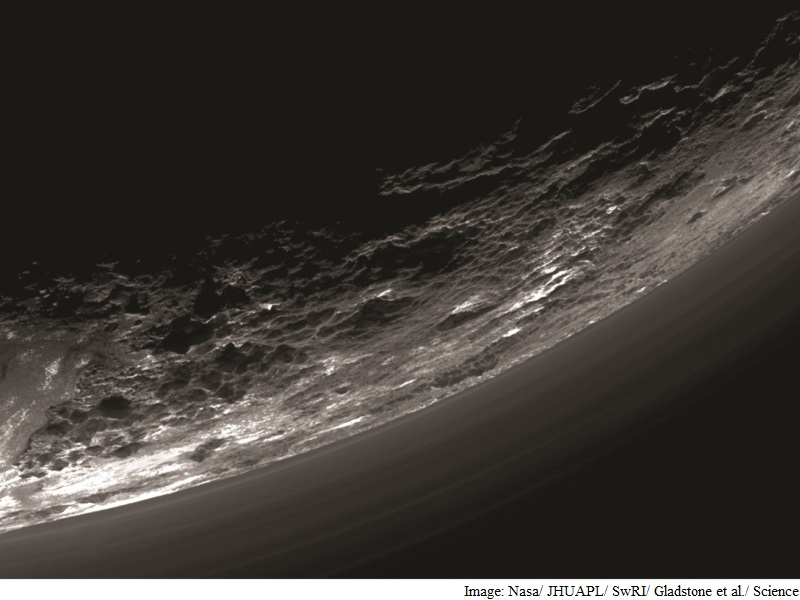- Home
- Science
- Science News
- Frigid Pluto Is Home to More Diverse Terrain Than Expected
Frigid Pluto Is Home to More Diverse Terrain Than Expected

The most detailed look at Pluto's surface to date has revealed an unexpected range of mountains, glacial flows, smooth plains and other landscapes, according to studies released on Thursday.
The unprecedented window into the so-called dwarf planet, which orbits the sun like other planets but is smaller, comes via high-resolution photographs from Nasa's New Horizons spacecraft. The interplanetary space probe made the first-ever visit to Pluto and its five moons last July.
Those images, chemical analyses and other data show a complex, geologically active world 3 billion miles from Earth, with an underground ocean and volcanoes that appear to spew ice, five research papers published in this week's Science journal said.
"It's a pretty wild place geologically," said planetary scientist William McKinnon of Washington University in St. Louis, Missouri.
Another scientist described the diversity of landscapes as "astonishing."
How the varied terrain came to be remains a mystery for the distant Pluto, which has an average surface temperature of minus 380 degrees Fahrenheit (minus 229 degrees Celsius).
Scientists suspect several processes at work, including vaporization of volatile ices, such as nitrogen, carbon monoxide and methane, into Pluto's cold and unexpectedly compact atmosphere.
Though smaller than Earth's moon, Pluto likely still has enough internal heat from its formation some 4.5 billion years ago to help maintain its most prominent feature, a smooth, 620-mile (1,000-km) wide, heart-shaped basin known as Sputnik Planum.
Relatively young mountains west of Sputnik Planum and mounds to the south are harder to explain. Scientists suspect both rest on blocks of water ice, though how that came to exist on Pluto is unknown.
"We are puzzled by almost everything," said Alan Stern, the New Horizons mission's lead scientist.
The studies show that Pluto's primary moon, Charon, had an active life but ran out of naturally occurring radioactive heat in its rocks and froze through about 2 billion years ago.
Scientists now believe Charon and Pluto's four other small moons owe their existence to a crash between Pluto and another Pluto-sized body early in the solar system's history.
Similar to Earth's moon, scientists suspect Pluto's natural satellites were formed from the debris that was hurled into space after the crash.
© Thomson Reuters 2016
For the latest tech news and reviews, follow Gadgets 360 on X, Facebook, WhatsApp, Threads and Google News. For the latest videos on gadgets and tech, subscribe to our YouTube channel. If you want to know everything about top influencers, follow our in-house Who'sThat360 on Instagram and YouTube.
Related Stories
- Samsung Galaxy Unpacked 2025
- ChatGPT
- Redmi Note 14 Pro+
- iPhone 16
- Apple Vision Pro
- Oneplus 12
- OnePlus Nord CE 3 Lite 5G
- iPhone 13
- Xiaomi 14 Pro
- Oppo Find N3
- Tecno Spark Go (2023)
- Realme V30
- Best Phones Under 25000
- Samsung Galaxy S24 Series
- Cryptocurrency
- iQoo 12
- Samsung Galaxy S24 Ultra
- Giottus
- Samsung Galaxy Z Flip 5
- Apple 'Scary Fast'
- Housefull 5
- GoPro Hero 12 Black Review
- Invincible Season 2
- JioGlass
- HD Ready TV
- Laptop Under 50000
- Smartwatch Under 10000
- Latest Mobile Phones
- Compare Phones
- Moto G15 Power
- Moto G15
- Realme 14x 5G
- Poco M7 Pro 5G
- Poco C75 5G
- Vivo Y300 (China)
- HMD Arc
- Lava Blaze Duo 5G
- Asus Zenbook S 14
- MacBook Pro 16-inch (M4 Max, 2024)
- Honor Pad V9
- Tecno Megapad 11
- Redmi Watch 5
- Huawei Watch Ultimate Design
- Sony 65 Inches Ultra HD (4K) LED Smart TV (KD-65X74L)
- TCL 55 Inches Ultra HD (4K) LED Smart TV (55C61B)
- Sony PlayStation 5 Pro
- Sony PlayStation 5 Slim Digital Edition
- Blue Star 1.5 Ton 3 Star Inverter Split AC (IC318DNUHC)
- Blue Star 1.5 Ton 3 Star Inverter Split AC (IA318VKU)

















